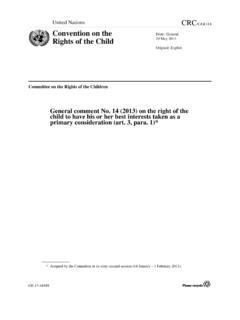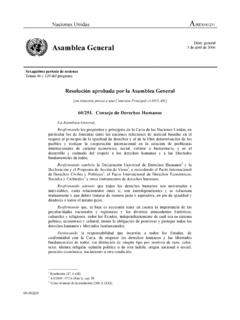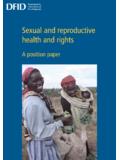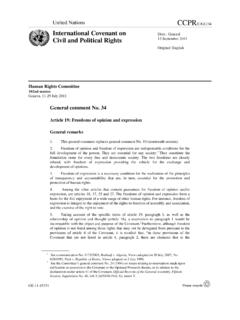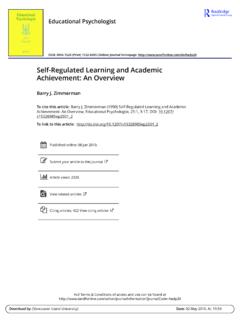Transcription of Gender Equality Policy - Office of the United Nations High ...
1 Gender EqualityPolicyGender EqualityPolicyDear colleagues,The OHCHR Gender Equality Policy that I approved on 9 September 2011 is now fully in force. It is the result of an extensive consultation process which started in late we advocate for women s rights and Gender Equality worldwide, I am conscious that we should first put these principles into practice in our daily lives, starting with our own Office . You will thus see that the Gender Equality Policy of OHCHR is largely an internal guidance document, outlining a joint vision, strategic priorities and processes for integrating Gender perspectives throughout the work of the Office . I would like to emphasize that this Policy applies to all human rights staff members at Headquarters and in Field Presences, including Human Rights Components of Peace Missions. Myself, the Deputy High Commissioner, the Assistant secretary -General, Directors, Chiefs of Branch, Heads of Field Presences and Chiefs of Section are primarily responsible for ensuring its implementation.
2 I will hold all staff accountable for contributing towards Gender integration therefore call on all of you to familiarize yourselves with the document and to understand its guiding principles and accountability mechanisms. The Policy is complemented by a Gender Equality strategic Plan, which maps out concrete actions required to operationalize the Policy , with detailed performance indicators, resources and timeframes for implementation. I count on your full cooperation in implementing the Gender Equality Policy and strategic Plan in your respective work, making Gender Equality a reality for our entire PillayUnited Nations High Commissioner for Human RightsForEword by thE hiGh CommissionEr OHCHR photo2 OHCHR photo3sCoPEHigh Commissioner, Deputy High Commissioner, Assistant secretary -General for Human Rights in New York, Directors, Chiefs of Branch, Heads of Field Presences, Heads of Human Rights Components of Peace Missions, Human Rights Advisers and Chiefs of Section, all staff members at Headquarters and Field levelEntry into ForCE 9 September 2011 Signature of HC and date of signaturerEviEw datEReview foreseen every four years, at the initiative of the Chief.
3 Women s Human Rights and Gender SectionGEndEr Equality PoliCyrEFErEnCEs and sourCEs OHCHR Policy Statement on Gender Mainstreaming and Human Rights of Women (2000) OHCHR Gender Mainstreaming Strategy (2002) Chief Executive Board resolution CEB/2006/2 on United Nations system-wide Policy on Gender Equality and the empowerment of women: focusing on results and impact (2006) Evaluation of OHCHR Performance in Gender Mainstreaming (2010) ECOSOC resolution 2010/29 on Mainstreaming a Gender perspective into all policies and programmes in the United Nations system (2010)annExEs Glossary ReferenceshistoryThe present Gender Equality Policy replaces OHCHR Policy Statement on Gender Mainstreaming and Human Rights of Women (2000)The Office of the High Commissioner, Palais Wilson in Geneva and statues representing victims of human rights violation41.
4 The Gender Equality Policy of the Office of the High Commissioner for Human Rights (OHCHR) provides internal guidance on how the Office aims to integrate a Gender perspective and women s human rights throughout Policy formulation, programme development and activity implementation, including project monitoring and To this end, the Policy is informed by the human rights-based approach and the Gender integration Policy of the United OHCHR is mandated to contribute to the realization of all human rights for all people. Accordingly, non-discrimination on the basis of sex is a fundamental principle of human rights law. In addition, OHCHR is required to implement the Gender integration Policy of the United The present Policy has been developed in response to the above-mentioned mandates, lessons learned over the past ten years and results of the internal evaluation on Gender mainstreaming conducted by OHCHR in 2010.
5 In general, the Policy aims to create an environment and shape a culture conducive to promoting women s human rights and to advancing Gender Within OHCHR, the need to integrate Gender aspects into the overall human rights approach of the Office was officially recognized in 2000, with the adoption of the first OHCHR Gender Policy Statement on Gender Mainstreaming and Human Rights of Women. This was later followed by an OHCHR Gender Mainstreaming Strategy in 2002, which aimed to facilitate progress in integrating Gender perspectives in the OHCHR activities. Both documents were developed prior to the articulation of the global strategies, outlined in OHCHR Management Plan, for the achievement of its mandate, which limited their application. Since 2005, women s rights and Gender integration has increasingly been recognized and accepted within OHCHR as a core principle, which should consistently and systematically inform all areas of the Office s human rights work.
6 The capacity to translate this core principle into operational activities was created in 2007 via the establishment of a special unit on Women s Human Rights and Gender . The evaluation of OHCHR Performance in Gender Mainstreaming (2010) confirmed, inter alia, that a revision of the existing Gender Policy statement was of importance to ensuring a more systematic approach in this regard. The present Gender Equality Policy takes into account current strategic thinking and is expected to provide clear Policy guidance for ensuring the proactive and consistent integration of Gender Equality in all aspects of the Office s The Policy is largely an internal guidance document, outlining a joint vision, strategic priorities and processes for integrating Gender perspectives throughout the Office . This Policy applies to all OHCHR staff members at Headquarters and in the Field, and is led by the High Commissioner, the Deputy High Commissioner, the Assistant secretary -General for Human Rights in New York, Directors, Chiefs of Branch, Heads of Field Presences including Missions and Chiefs of The Policy gives broad strategic orientations for implementation, including institutionalizing Gender Equality in the organizational culture of OHCHR, and advancing Gender Equality throughout all areas of the Office s mandate (see Section 6).
7 The Policy be complemented by a detailed strategy as well as a set of tools on Gender integration. United Nations /OHCHR photoOHCHR staff visit a place of detention in Nepal (2009)6 United Nations / OHCHR photo74. PoliCyFramEwork and The Gender Equality Policy is based on the international human rights framework, including the Universal Declaration of Human Rights, the International Covenant on Economic, Social and Cultural Rights, the International Covenant on Civil and Political Rights, and the Convention on the Elimination of All Forms of Discrimination against Women. It reflects the application by the Office of international human rights standards, norms and principles, which include Gender Equality and non-discrimination. Gender integration (or mainstreaming)1 is the process of assessing the implications for women and men of any planned action, including legislation, policies or programmes, in all areas and at all levels.
8 It is a strategy for making women s, as well as men s concerns and experiences, an integral dimension of the design, implementation, monitoring and evaluation of policies and programmes; and this in all political, economic and societal spheres, so that women and men benefit equally, 1 A 2008 evaluation of the Office s performance in mainstreaming human rights within the United Nations noted that staff avoided using the term mainstreaming due to lack of clarity about its meaning. Throughout this Policy the term Gender integration is used rather than Gender mainstreaming , unless there is an explicit reference to an existing document featuring the word mainstreaming .thereby ensuring that inequality is not perpetuated. Gender integration goes hand in hand with the promotion and protection of women s human rights and the elimination of discrimination against women.
9 The ultimate goal is to achieve Gender equality2 (see more on Gender integration in the Glossary, annex 1). The Office s areas of expertise, such as human rights treaties (particularly the monitoring of the Convention on the Elimination of All Forms of Discrimination against Women (CEDAW) provide an important entry point to promoting Gender Equality and women s rights, especially at country level. Human rights treaty bodies, special procedures and the Universal Periodic Review (UPR) can make a valuable contribution towards to integrating a Gender perspective in the understanding of human rights norms through their assessment of compliance with treaty obligations by States Parties. Moreover, implementing the Gender Equality Policy will impact the work of OHCHR at large, not only in carrying out applied research on critical human rights issues affecting women in particular, but also on the ground.)
10 This ground work will be evidenced by integrating a Gender perspective, while mainstreaming human rights in the work of the United Nations Country Teams and helping strengthen national institutions and civil society organizations striving for improved Gender Equality . 2 ECOSOC Agreed Conclusions, as contained in resolution 1997/2 Human rights banner at the exhibit of artwork made by victims of torture, Geneva (2011) The vision of the Gender Equality Policy is that all OHCHR Divisions, the New York Office and Field Presences, with the support of the Women s Human Rights and Gender Section (WRGS), develop their own approach to integrating a Gender perspective in their work and applying Gender Equality principles when working with external partners. In addition, all staff members should commit to acquiring basic knowledge in their respective areas of work.
